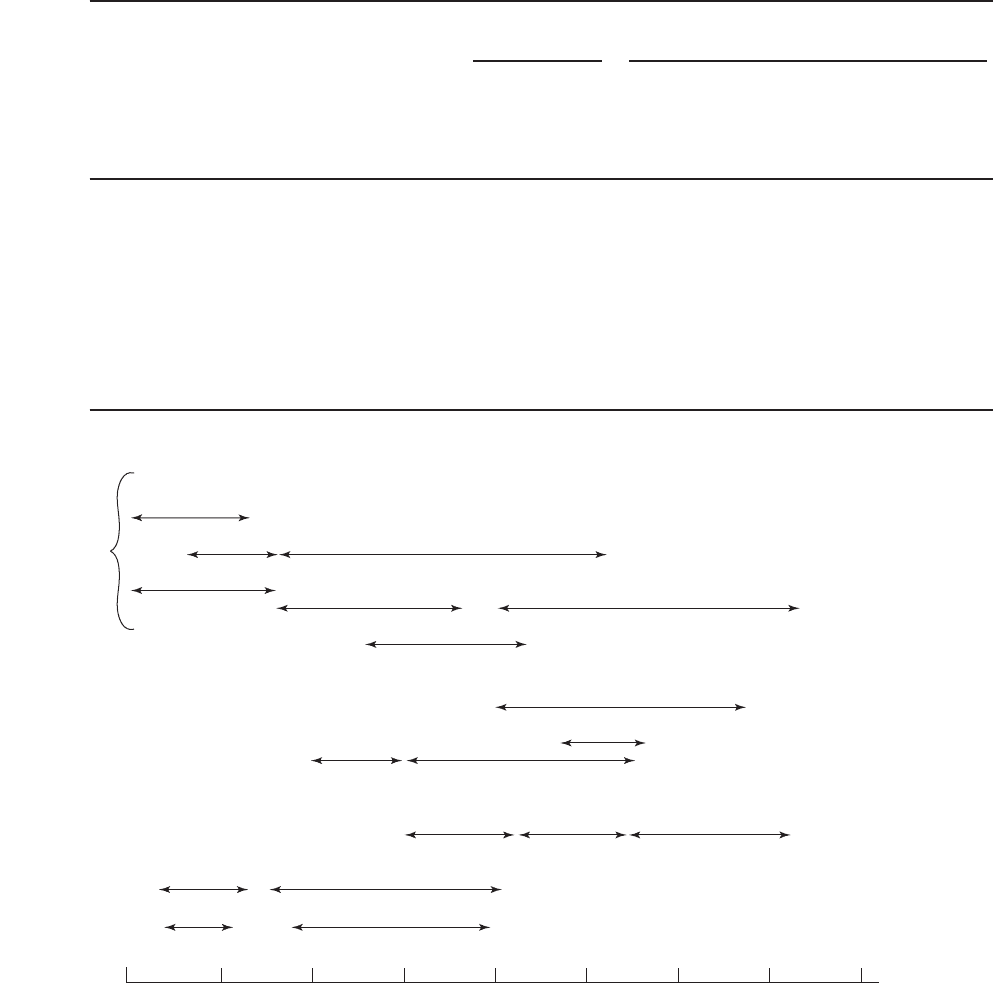Water and Wastewater Engineering
Подождите немного. Документ загружается.

WATER PLANT RESIDUALS MANAGEMENT 15-57
appropriate centrifuge system. Assume a two-shift basis, that is, 16 h/d to minimize
labor costs. Use the approximate method for estimation for sludge volume reduction.
15-25. In the continuing management of Tumanipharmz’s backwash solids ( Problems 15-14
and 15-18 ), your fir
m has been asked to perform a preliminary selection of a cen-
trifuge. The sludge from a thickener at 3% solids is to be pumped to the centrifuge.
Using Table 15-8 , select an appropriate centrifuge system. Assume a two-shift basis,
that is, 16 h/d to minimize labor costs.
15-26. In the continu
ing management of Pherric’s coagulant treatment sludge, your firm
has been asked to perform a preliminary selection of a CBFP. The sludge from a
thickener ( Problem 15-17 ) at 4% solids is to be pumped to the CBFP. Determine the
appropriate belt width for the press. Assume a two-shift basis, that is, 16 h/d to mini-
mize labor co
sts.
15-27. In the continuing management of Tumanipharmz’s backwash solids, your firm has
been asked to perform a preliminary selection of a CBFP, that is, loading rate and
belt width. The sludge from a thickener at 3% solids is to be pumped to the CBFP.
Determine the appropriate belt width for the press. Assume a two-shift ba
sis, that is,
16 h/d to minimize labor costs.
15-28. In the continuing management of Calcareous’s lime softening solids, your firm has
been asked to perform a preliminary selection of a diaphragm filter press. The sludge
from the upflow solids contact tank at 10% solids is to be pumpe
d to the press. Using
Table 15-9 , select an appropriate filter press system. Assume a two-shift basis, that
is, 16 h/d to minimize labor costs. Also assume the specific gravity of the dewatered
sludge is 1.2 and that it is to be dewatered to 35% solids with an 8-hour press time.
15-29. Assuming a three lagoon sy
stem for the area estimated for the lagoons in Problem
15-20 , prepare a scale drawing of a typical lagoon (plan and profile) and an overall
arrangement of the lagoons including access roads. Estimate the total area (in ha) re-
quired for the lagoons and access roads.
15-30. For the sand drying bed area calculated for Pherric ( Problem 15-22 ), prepare a di-
mensioned
scale drawing of a typical bed (plan and profile) and an overall arrange-
ment of the number of beds including access roads. Assume bed runners will be
provided. Show these in the scale drawing of a typical bed. Estimate the total area (in
ha) required for the beds and access roads. Note: you will have to do some research
to find the
dimensions of a front-end loader to establish the stop gate entrance width
and placement of bed runners.
15-13 DISCUSSION QUESTIONS
15-1. Match the following residual characteristics with the type of residual.
a. 10% solids ( ) Coagulation sludge
b. 1% solids ( ) Lime sludge
c. 400 mg/L solids ( ) Spent filter backwash
15-58 WATER AND WASTEWATER ENGINEERING
15-2. A lime softening plant located in Michigan has space available for either lagoons or
sand drying beds. Which is more likely to be selected? Explain why.
15-3. A lime softening plant located in a highly developed urban area has little space for
sludge dewatering. Ultimately the sludge will be hauled to agricultural land for ap-
plic
ation. Which of the following mechanical dewatering processes is favored: basket
centrifuge, CBFP, or plate and frame filter press? Explain why.
15-4. The TCLP test is s pecified for regulatory control of arsenic treatment residuals.
Describe the test in general terms and what a failu re to pass the test implies for the
disposal of the residu
als.
15-14 REFERENCES
ASCE (1990) Water Treatment Plant Design, American Society of Civil Engineers, McGraw-Hill, New
York, pp. 336–338.
AWWA (1996) Management of Water Treatment Plant Residuals, American Water Works Association,
Denver, Colorado.
AWWA (2003) “Committee Report: Residuals Management for Low-Pressure Membranes,” Journal of
American Water Works Association, vol. 95, no. 6, pp. 68–82.
AWWA (2004) “Committee Report: Current Perspectives on Residuals Management for Desalting
Membranes,” Journal of American Water Works Association, vol. 96, no. 12, pp. 73–87.
AWWA (2005) Microfiltration and Ultrafiltration Membranes for Drinking Water, AWWA Manual
M53, American Water Works Association, Denver, Colorado.
A yol, A., S. K. Dentel, and A. Filibeli (2005) “Dual Polymer Conditioning of Water Treatment
Residuals,” Journal of Environmental Engineering, vol. 131, no. 8, pp. 1,132–1,138.
Black, A. P. and C. G. Thompson (1975) Plant Scale Studies of the Magnesi
um Carbonate Water Treatment
Process, U.S. Environmental Protection Agency Publication No. EPA-660/2-75-006, Cincinnati, Ohio.
Boyle, W. H. (1978) “Ensuring Clarity and Accuracy in Torque Determinations,” Water and Sewage
Works, vol. 125, no. 3. p. 76.
Cornwell, D. A. (1999) “Water Treatment Plant Residuals Management,” in R. D. Letterman (ed.) Water
Quality and Treatment, 5th ed., American Water Works Association, McGraw-Hill, New York,
pp. 16.1–16.51.
Cornwell, D. A. (2006) Water Treatment Residuals Engineering, AWWA Research Foundation,
Denver, Colorado.
Cornwell, D. A. and C. Vandermeyden (1999) “Sizing Residuals Drying Beds,” Journal of American
Water Works Association, vol. 91, no. 11, pp. 94–105.
Cornwell, D. A., M. J. MacPhee, R. Muter, J. Novak, M. Edwards, J. L. Parks, and C. Itle (2003) Disposal
of Waste Resulting from Arsenic Removal Processes, AWWA Research Foundation and American
Water Works Association, Denver, Colorado.
Davis, M. L. and D. A. Cornwell (2008) Introduction to Environmental Engineering, McGraw-Hill,
Dubuque, Iowa, pp. 311–324.
Dick, R. I. (1970) “Thickening,” in E. F. Gloyna and W. W. Eckenfelder (eds.), Advances in Water
Quality Improvement—Physical and Chemical Processes, University of Texas Press, Austin, p. 380.
Gregory, R., T. F. Zabel, and J. K. Edzwald (1999) “Sedimentation and Flotation,” in R. D. Letterman
(ed.) Water Quality and Treatment, 5th ed., American Water Works Association, Mc
Graw-Hill, New
York, pp. 7.47–7.80.
GLUMRB (2003) Recommended Standards for Water Works, Great Lakes–Upper Mississippi River
Board of State and Provincial Public Health and Environmental Managers, Health Education
Services, Albany, New York, pp. 34, 119–123.
WATER PLANT RESIDUALS MANAGEMENT 15-59
Kawamura, S. (2000) Integrated Design and Operation of Water Treatment Facilities, 2nd ed., John
Wiley & Sons, New York, p. 387.
Le Gouellec, Y. A., D. A. Cornwell, and M. J. MacPhee (2004) “Treating Microfiltration Backwash,”
Journal of American Water Works Association, vol. 96, no. 1, pp. 72–83.
Marshall, T. (2002) “Sweeter Soil with Substantial Savings,” Ohio’s Country Journal, vol. 11, no. 5,
pp. 21–22.
Mickey, M. (1993) “Membrane Concentrate Disposal Issues,” Proceedings of the 4th Joint WEF and
AWWA Conference on Biosolids and Res
iduals Management, Water Environment Federation,
Alexandria, Virginia.
MWH (2005) Water Treatment: Principles and Design, John Wiley & Sons, Hoboken, New Jersey,
pp. 844, 927, 926, 1661, 1665, 1666, 1669, 1686.
Novak, J. T. (1993) Demonstration of Cropland Application of Alum Sludges, American Water Works
Association Research Foundation, Denver, Colorado.
Parrotta, M. J. (1991) “Radioactivity in Water Treatment Wastes: A USEPA Perspective,” Journal of
American Water Works Association, vol. 83, no. 4, pp. 13
4–140.
Peck, B. E. and J. S Russell (2005) “Process Residuals,” in E. E. Baruth, (ed.), Water Treatment Plant
Design, American Water Works Association and American Society of Civil Engineers, McGraw-Hill,
New York, pp. 17.1–17.70.
Prakash, P. and A. K. Sengupta (2003) “Selective Coagulant Recovery from Water Treatment Plant
Residuals Using Donnan Membrane Process,” Environmental Science & Technology, vol. 37, no. 19,
pp. 4,468–4,474.
Shorney-Darby, H., G. Dias, P. Ryan, C. Hidahl, R. Henderson, and K. Abrahm (2007) “Expanding a
Conventional Water Treatment Plant with Low-Pressure Membranes,” Journal of American Water
Works Association, vol. 99, no. 12, pp. 52–60.
Tripp, A. R. and D. A. Clifford (2006) “Ion Exchange for the Remediation of Perchlorate-Contaminated
Drinking Water,” Journal of American Water Works Association, vol. 98, no. 4, pp. 105–114.
U.S. EPA (1979) Process Design Manual: Sludge Treatment and Disposal, U.S. Environmental
Protection Agency Publication No. 625/1-79-011, Cincinnati, Ohio, pp. 5.1–5.15.
U.S. EPA (2000) Regulations on the Disposal of Arsenic Residuals from Drinking Water Treatment
Plants, U.S. Environmental Protection Agency Publication No. EPA/600/R-00/25, Washington, D.C.
V a n dermeyden, C. and D. A. Cornwell (1993) A U.S. Perspective of Beneficial Use Programs for Water
Treatment Plant Residuals,” in Proceedings of WEF Biosolids Conference, Water Environment
Federation, Washington, D.C.
V e silind, P. A. (1979) Treatment and Disposal of Wastewater Sludges, Ann Arbor Science, Ann
Arbor, Michigan.
WEF (1998) Design of Municipal Wastewater Plants, 4th ed.
Westerhoff, G. P. and D. A. Cornwell (1978) “A New Approach to Alum Recovery,” Journal of American
Water Works Association, vol. 70, no. 12, p. 709.
Yoshioka, N., et al. (1957) “Continuous Thickening of Homogenous Flocculated Slurries,” Chemical
Engineering, Tokyo (in Japanese).

16-1
16-5 CHAPTER REVIEW
16-6 PROBLEMS
16-7 DISCUSSION QUESTIONS
16-8 REFERENCES
DRINKING WATER PLANT PROCESS SELECTION
AND INTEGRATION
16-1 INTRODUCTION
16-2 PROCESS SELECTION
16-3 PROCESS INTEGRATION
16-4 SECURITY
16
CHAPTER
16-2 WATER AND WASTEWATER ENGINEERING
16-1 INTRODUCTION
The primary goal of municipal water treatment is to supply an adequate quantity of potable water
to the public. A secondary but essential goal is to make the water palatable. Since 1899, when
George Warren Fuller demonstrated the efficacy of combining coagulation, flocculation, settling,
and filtration to produce consistently high quality water from the Ohio River—despite it
s exceed-
ingly high variations in raw water quality—environmental engineers have assembled a “train” of
processes to achieve a desired water quality. Because no single process is 100 percent efficient
and because processes fail, the treatment train concept is now recognized as the best means to
provide mult
iple barriers to protect the water supply from intrusion of contaminants.
The treatment train/multiple barrier concept is illustrated in the arrangement of the conven-
tional surface water coagulation plant beginning at the end of the treatment process.
• Although disinfection is quite effective in destroying vegetative pathogens, it is not very
effective in destroying spore-form
ing organisms. Furthermore, the presence of turbidity
interferes with disinfection of vegetative organisms by shielding them from the disinfectant
as well as consuming excessive amounts of d isinfectant to achieve a prescribed level of
disinfection.
• B y preceding the disinfection process with a filtration pro
cess, both the excess turbidity and
the organisms resistant to disinfection can be removed. However, the filtration systems are
expensive to build and operate. In addition, they can become overloaded with a resultant
breakthrough of both turbidity and pathogens.
• B y preceding the filtration process with settling, a majority of the tu
rbidity can be removed.
This allows for a reduction in the filter size as well as improving its overall performance.
Because of the very low settling velocity of the turbidity, as well as the turbulence in real
settling tanks, they do not achieve high efficiency.
• The introduction of the coagulation/flocculation process ahead of the settling tank results
in the production of large floc that settles better than individual turbidity particles. This
improves the efficiency of the settling tanks.
Thus, the overall objective of the coagulation treatment train is to make the disinfection process
more efficient. In addition, multiple barriers to the pathogens are put in place because pathogens
are removed in each of the process
es that precede disinfection.
The objectives of this chapter are to provide an approach to process selection to form treat-
ment trains and to summarize the essential factors to be considered in selecting water treatment
processes. Ancillary topics include plant layout, plant hy draulics, supervis
ory control and data
acquisition (SCADA), and security.
16-2 PROCESS SELECTION
Fundamental Precepts
E xperience has taught us the following fundamental precepts in process selection (MWH, 2005):
1 . The raw water quality of every source is different.
2. Raw water quality is variable.
DRINKING WATER PLANT PROCESS SELECTION AND INTEGRATION 16-3
3. There is no standard water treatment plant design that is applicable to all sources.
4. For every source, a number of treatment process alternatives are available.
5. Site conditions often limit the types of treatment process that can be used.
6. Retrofitting and upgrading of existing plants requires creative s
olutions that are not pre-
sented in standard textbooks such as this one.
7. Pilot plant testing is highly recommended in the selection of retrofit and upgrade
alternatives.
8. Pilot plant testing requires careful planning and execution to obtain u seful design and
operating criteria.
9. It is essential that the multibarrier c
oncept be a feature of all designs.
10. Operator experience is invaluable in developing a design.
Evaluation of Process Options
While experts with a large bod y of knowledge gained from experience will often be able to
screen the universe of available processes to select a set of options for study and evaluation, the
sorting process they use is not intuitively obvious. In simplified form, the sorting process may
be represented as a matrix table in which all the relevant treatm
ent processes are listed on one
axis and the factors related to process selection are listed on another axis. Each process is given
a rating or ranking for each of the factors. In addition, a weighting system may be employed to
account for greater influence of more important aspects of some of the factors than others
.
For academic purposes, Tables 16-1 , 16-2 , and 16-3 illustrate some matrices that provide
information for initial screening. Other aids for initial screening are Figure 16-1 and the tables in
previous chapters that are summarized in Table 16-4 .
A n umber of other tables and decision trees are available in the literature to aid in making
selec
tions. Some of these are very useful in refining screening selections. For example Monk
(1987) provides comparisons of rapid sand filter media, underdrain systems, backwash systems,
auxiliary scour, and filter control systems.
Factors that
should be included in decisions on water treatment processes include (Logsdon,
Hess, and Horsley, 1999):
• Contaminant removal
• Source water quality
• Reliability
• Existing conditions
• Process flexibility
• Utility capabilities
• Costs
• Environmental co
mpatibility

16-4 WATER AND WASTEWATER ENGINEERING
Membrane processes
Contaminant
categories
Acration
and
stripping
Coagulation,
sedimentation
or DAF,
filtration
Lime
softening
Chemical
oxidation
and
disinfection
Microfiltration—
0.1 m pores
Ultrafiltration—
0.01 m pores
Nanofiltration—
0.001 m pores
Inorganic chemicals
Antimony
A
a
Arsenic (3+)
AO
b
AO A
Arsenic (5+) A A A
Barium AA
Beryllium AA A
Cadmium AA A
Chromium (3+) A A A
Chromium (6+) A
CyanideA
FluorideA
Mercury AA
Nickel A A
Nitrate A
Nitrite A
Selenium (4+) A A
Selenium (6+) A
Thallium A
Organic contaminants
VOCs A
SOCs
Pesticides & herbicides A
DOC A A
Radionuclides
Rad
ium (226 & 228) A A
Uranium A
Microorganisms
Algae A A A A
Bacteria A A A A A
Protazoa A A A A A
Virus AA
Turbidity AA A A
TABLE 16-1
Appropriateness of water treatment processes for removing primary contaminants
a
A appropriate process.
b
AO appropriate when used in conjuncrtion with oxidation.
A dapted from NRC, 1997.

DRINKING WATER PLANT PROCESS SELECTION AND INTEGRATION 16-5
Ion exchange Adsorption
Contaminant
categories
Reverse osmosis—
nonporous
Electrodialysis/
ED
reversal Anion Cation
Granular
activated
carbon (GAC)
Powdered
activated
carbon (PAC)
Acitvated
alumina
(AA)
Inorganic chemicals
Antimony A
Arsenic (3+) A A A A
Arsenic (5+) A A A A
Barium AA A
Beryllium AA
Cadm
ium AA A
Chromium (3+) A A A
Chromium (6+) A A A
Cyanide
FluorideAA A
Mercury AA
Nickel A A A
Nitrate A A A
Nitrite A A A
Selenium (4+) A A A A
Selenium (6+) A A A A
Thallium AA A
Organic contaminants AA
VOCs AAA
SOCs AAA
Pesticides & herbicides AAA
DOC
Radionuclides AA
Radium (226 & 228) A A A
Uranium
Microorganisms
Algae
Bacteria
Protazoa
Virus
Turbidity

16-6 WATER AND WASTEWATER ENGINEERING
Membrane process
Rule EDR RO NF UF MF
SWTR/ESWTR
a
no yes yes yes yes
CR
b
no yes yes yes yes
LCR
c
yes yes yes no no
IOC
d
yes yes yes no no
SOC
e
no yes yes yes (PAC) yes (PAC)
Radionuclides yes (no radon) yes (no radon) yes (no radon) no no
DBPR
f
no yes yes yes( coagulation) yes ( coagulation)
GWDR
g
no yes (expected) yes (expected) yes (expected) yes (expected)
Arsenicyes yes yes yes ( coagulation) yes ( coagulation)
Sulfates yes yes yes no no
TABLE 16-3
Summary of membrane process applications for drinking water regulations
a
SWTR/ESWTR—Surface water treatment rule/enhanced surface water treatment rule.
b
CR—Coliform rule.
c
LCR—Lead and copper rule.
d
IOC—Inorganic chemicals.
e
SOC—Synthetic organic chemicals.
f
DBPR—Disinfection by-product rule.
g
GWDR—Ground water rule.
Source: Taylor and Wiesner, 1999.
TABLE 16-2
Appropriateness of water treatment processes for removing secondary contaminants
Membrane processes
Contaminant
categories
Acration
and
stripping
Coagulation,
sedimentation
or
DAF,
filtration
Lime
softening
Chemical
oxidation
and
disinfection
Microfiltration—
0.1 m
pores
Ultrafiltration—
0.01 m
pores
Nanofiltration—
0.001 m
pores
Chloride
Color A A A
Hardness AA
Iron AO A ANDO
a
Manganese AO A ANDO
Sulfate A
TDS A
Taste & odor A A
Zinc AA
a
ANDO appropriate when no dissolved oxygen enters the process.
A dapted from NRC, 1997

DRINKING WATER PLANT PROCESS SELECTION AND INTEGRATION 16-7
Reverse
Osmosis
0.0001 0.001 0.01 0.1 1.0 10 100 1000 10,000
Nanofiltration
Electro dialysis
Ultra filtration
Coagulation
Microfiltration
Conventional filtration
Algae
Cysts
Viruses Bacteria
Silt
Clay
Sand
Natural organic matter (NOM)
Humic acidsMetal ions
Aqueous salts
Size, µm
Processes
FIGURE 16-1
Aid for initial screening of processes based on size of contaminants.
Ion
exchange Adsorption
Contaminant
categories
Reverse
osmosis—
nonporous
Electrodialysis/
ED
reversal Anion Cation
Granular
activated
carbon (GAC)
Powdered
activated
carbon (PAC)
Acitvated
alumina
(AA)
ChlorideA A
Color A A A
Hardness AA A
Iron ANDO A
Manganese ANDO A
Sulfate A A
TDS A A
Taste & odor A A
Zinc AA A
